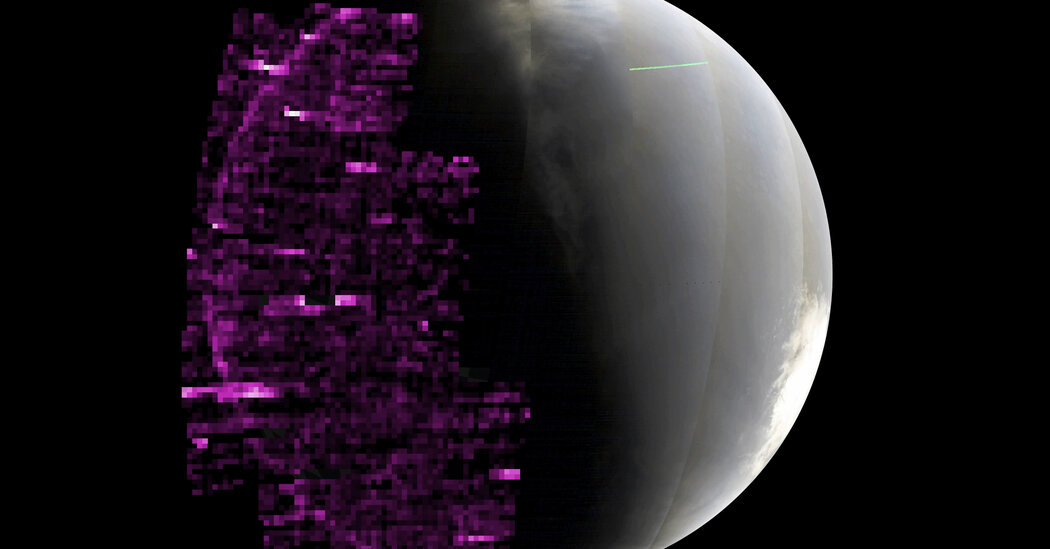The sun fired off a volley of radiation-riddled outbursts in May. When they slammed into Earth’s magnetic bubble, the world was treated to iridescent displays of the northern and southern lights. But our planet wasn’t the only one in the solar firing line.
A few days after Earth’s light show, another series of eruptions screamed out of the sun. This time, on May 20, Mars was blitzed by a beast of a storm.
Observed from Mars, “this was the strongest solar energetic particle event we’ve seen to date,” said Shannon Curry, the principal investigator of NASA’s Mars Atmosphere and Volatile Evolution orbiter, or MAVEN, at the University of Colorado, Boulder.
When the barrage arrived, it set off an aurora that enveloped Mars from pole to pole in a shimmering glow. If they were standing on the Martian surface, “astronauts could see these auroras,” Dr. Curry said. Based on scientific knowledge of atmospheric chemistry, she and other scientists say, observers on Mars would have seen a jade-green light show, although no color cameras picked it up on the surface.
But it’s very fortunate that no astronauts were there. Mars’s thin atmosphere and the absence of a global magnetic shield meant that its surface, as registered by NASA’s Curiosity rover, was showered by a radiation dose equivalent to 30 chest X-rays — not a lethal dose, but certainly not pleasant to the human constitution.
While last month’s auroras were bewitching, they served as a reminder that Mars can be a dangerous, radiation-smothered place and that future astronaut visitors will have to beware. “These solar storms pack a punch,” Dr. Curry said.
Lava tubes — lengthy caves forged by volcanic activity — can provide Martian voyagers with hardy refuge from solar storms. But with the sun’s deleterious particles sometimes reaching Mars in minutes, earthlings will have to be light on their feet.
In other words, if you’re a Martian astronaut, “you’d better keep up to date on your space weather forecasts,” said James O’Donoghue, a planetary astronomer at the University of Reading in England.
When the May 20 mega-eruption emerged, it was immediately obvious that it was formidable. A powerful solar flare reached Mars first, bathing it in X-rays and gamma rays. Hot on its heels was a potent coronal mass ejection — a buckshot of charged particles from the sun. “They looked pretty fast to me,” said Mathew Owens, a space physicist at the University of Reading.
When particles from a solar salvo reach humanity’s home, they are caught in Earth’s magnetic field and spiral down into the north and south magnetic poles. There, they bounce off different gas molecules in the atmosphere, temporarily energizing them and unleashing bursts of myriad, visible colors.
Mars lost its magnetic field eons ago when its iron-rich innards stopped churning, so May’s solar bombardment was not intercepted. “There’s nothing to stop these particles plowing right into the atmosphere,” said Nick Schneider, the lead scientist working on the Imaging Ultraviolet Spectrograph on MAVEN at the University of Colorado, Boulder.
Subjected to a global pummeling, auroras ignited across the entire planet. The MAVEN orbiter documented a thunderous ultraviolet glow, while a light green hue would have been visible on the surface as it emanated from the atmosphere’s agitated oxygen atoms.
Some of Mars’s robotic residents encountered the more unpleasant effects of the storm. Charged particles hit Curiosity’s navigation cameras and the star tracker cameras for the Mars Odyssey and Mars Reconnaissance Orbiter satellites, inundating them all with static like “snow.”
Solar storms can also degrade a spacecraft’s solar panels. May’s maelstrom was no exception. “Everybody’s solar panels took a hit,” Dr. Curry said. She added that one solar storm like that of May 20 “causes about the same amount of degradation that we typically see over a year.”
None of the spacecraft were deeply damaged — and the scientific data they recorded has been warmly received. But these orbiters may not always emerge unscathed in the face of the sun’s fury. “The science team is thrilled every time we see these events,” Dr. Curry said. “The spacecraft ops team, less so.”
#Mars #Cooked #Solar #Storm,
#Mars #Cooked #Solar #Storm
